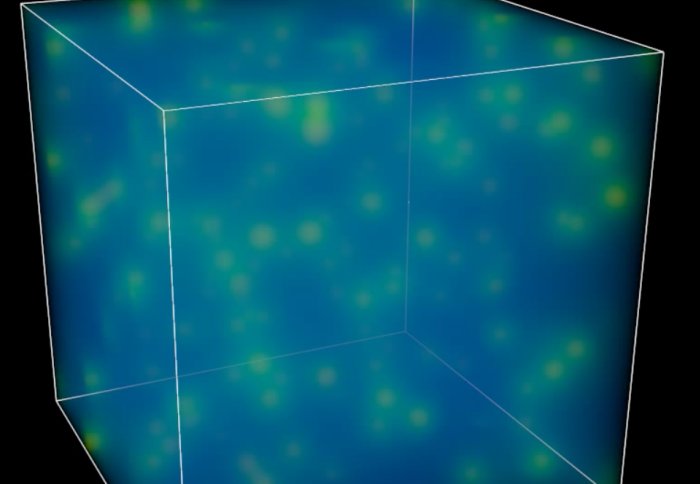New data on weird state of matter could help the development of fusion power

Electron density simulation in warm dense matter. Image: Travis Sjostrom
Researchers have determined how warm dense matter, a state that exists during fusion reactions, behaves at different temperatures and pressures.
Warm dense matter is a state where materials act in a different way than traditional solid, liquid, gas or plasma. It is thought to exist in the cores of some planets and in the atmospheres of white dwarf stars, but it can also be created in the lab.
Warm dense matter plays a role in inertial confinement fusion, a process aimed at producing clean fuel from hydrogen. Lasers are fired at hydrogen fuel in order to compress the atoms, causing them to fuse and release energy.
Until now there was essentially no accurate theory of warm dense matter behaviour – we did not know what to expect. Now we have the numbers, and can predict what it does at different temperatures and pressures.
– Professor Matthew Foulkes
During this process the fuel passes through a state of warm dense matter as the electrons are heated. The state only lasts for a few microseconds, but its behavior can affect subsequent states of matter.
For example, one of the problems of inertial confinement fusion is that the atoms are not compressed evenly and the reaction fizzles out, making fusion difficult. Knowing how the electrons behave during the warm dense matter phase could help researchers control this part of the reaction better.
Although measurements of warm dense matter have been made in the lab, until now there was no general picture of how it behaves. But in research published this week in Physical Review Letters, a team from Imperial College London, Kiel University and Los Alamos National Laboratory have revealed the first comprehensive and accurate simulations of electron behavior in warm dense matter.
Their data will allow researchers to better simulate warm dense matter and understand what their experiments are telling them.
Co-author Professor Matthew Foulkes from the Department of Physics at Imperial, said: “Until now there was essentially no accurate theory of warm dense matter behaviour – we did not know what to expect. Now we have the numbers, and can predict what it does at different temperatures and pressures.”
astronomical questions
Warm dense matter is a state that exists at temperatures of ten to ten thousand times room temperature. At these temperatures, the electrons have a lot more energy and can move around, but they are still tightly packed together, causing them to interact in strange ways.
This has made them difficult to predict, but by using equations from quantum theory, the team determined the phase diagram of warm dense matter – the map of how it behaves at all temperatures and pressures.
As well as fusion reactions, a model of warm dense matter behaviour will allow scientists to probe more astronomical questions. Study co-author Professor Michael Bonitz from the University of Kiel, Germany, said: “Our results will constitute the basis of future warm dense matter research. An improved understanding of warm dense matter will be the key to answering fundamental questions in astrophysics.”
For example, warm dense matter in Jupiter’s core is thought to contribute to the planet’s large magnetic field, and warm dense matter in the atmosphere of white dwarf stars determines their cooling rate, and thus their age.
-
'Ab Initio Quantum Monte Carlo Simulation of the Warm Dense Electron Gas in the Thermodynamic Limit' by Tobias Dornheim, Simon Groth, Travis Sjostrom, Fionn D. Malone, W. M. C. Foulkes, and Michael Bonitz is published in Physical Review Letters.
Article text (excluding photos or graphics) © Imperial College London.
Photos and graphics subject to third party copyright used with permission or © Imperial College London.
Reporter
Hayley Dunning
Communications Division